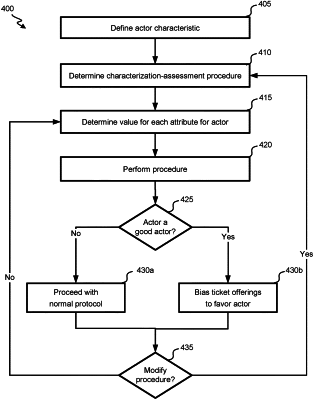| CPC G06Q 10/02 (2013.01) [G06Q 30/02 (2013.01); H04L 63/1483 (2013.01)] | 20 Claims |

|
1. A method for identification of characteristics of users in association with events, the method comprising:
extracting a value of each attribute from a set of attributes for a first set of users;
determining attendance data of a first set of user devices in a first event, associated with an entity, wherein:
the first set of user devices is associated with the first set of users, and
the attendance data indicates a presence or an absence of the first set of users in the first event;
inputting the value of each of the set of attributes and the attendance data into a machine learning model;
predicting, by the machine learning model, whether the first set of users will attend a second event based on the value of each of the set of attributes, using a pseudo-random factor at random time wherein the second event is associated with the entity;
identifying, by the machine learning model, a subset of attributes from the set of attributes based on the prediction that whether the first set of users will attend the second event, wherein the subset of attributes are identified for analysis of characteristics of the first set of users;
executing the machine learning model to generate a first character assessment procedure for analysis of characteristics of the first set of users predicted to attend the second event associated with the entity;
receiving a first request for a plurality of tickets to the second event from a second user device associated with a second user;
in response to the first request for the plurality of tickets received from the second user device, determining characteristics of the second user based on the character assessment procedure, wherein:
the characteristics of the second user is determined as one of a good actor or a bad actor, and
a probability of the good actor to attend the second event is greater than a probability of the bad actor to attend the second event;
generating a queue of requests of the good actor and the bad actor wherein:
request of the bad actor is held for a hold period, and
request of the good actor is offered by discounts;
transmitting interface data to the second user device based on the characteristics of the second user, wherein the second user device is enabled to display information related to the plurality of tickets to the second event, based on the interface data to the good actor;
pushing the request of the bad actor to the queue of requests, wherein the bad actor is a robotic user with lower probability of attending the event as determined based on the character assessment procedure.
|